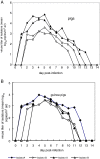Airborne spread and infection of a novel swine-origin influenza A (H1N1) virus
- PMID: 23800032
- PMCID: PMC3700749
- DOI: 10.1186/1743-422X-10-204
Airborne spread and infection of a novel swine-origin influenza A (H1N1) virus
Abstract
Background: The novel swine-origin influenza A (H1N1) virus (S-O 2009 IV) can cause respiratory infectious diseases in humans and pigs, but there are few studies investigating the airborne spread of the virus. In January 2011, a swine-origin H1N1 epidemic emerged in eastern China that rapidly spread to neighboring farms, likely by aerosols carried by the wind.
Methods: In this study, quantitative reverse transcription polymerase chain reaction (RT-PCR) was used to detect viruses in air samples from pig farms. Based on two aerosol infection models (Pig and guinea pig), we evaluated aerosol transmission and infection of the novel S-O 2009 IV isolate.
Results: Three novel S-O 2009 IV were isolated from the diseased pig. The positive rate and viral loads of air samples were 26.1% and 3.14-5.72 log₁₀copies/m³ air, respectively. In both pig and guinea pig infection models, the isolate (A/swine/Shandong/07/2011) was capable of forming aerosols and infected experimental animals at a range of 2.0-4.2 m by aerosols, but aerosol route was less efficient than direct contact.
Conclusions: The results indicated that S-O 2009 IV is able to be aerosolized by infected animals and to be transmitted to susceptible animals by airborne routes.
Figures




Similar articles
-
Detection of airborne influenza a virus in experimentally infected pigs with maternally derived antibodies.Transbound Emerg Dis. 2014 Feb;61(1):28-36. doi: 10.1111/j.1865-1682.2012.01367.x. Epub 2012 Jul 25. Transbound Emerg Dis. 2014. PMID: 22827737
-
Airborne detection and quantification of swine influenza a virus in air samples collected inside, outside and downwind from swine barns.PLoS One. 2013 Aug 8;8(8):e71444. doi: 10.1371/journal.pone.0071444. eCollection 2013. PLoS One. 2013. PMID: 23951164 Free PMC article.
-
Evidence for Cross-species Influenza A Virus Transmission Within Swine Farms, China: A One Health, Prospective Cohort Study.Clin Infect Dis. 2018 Feb 1;66(4):533-540. doi: 10.1093/cid/cix823. Clin Infect Dis. 2018. PMID: 29401271 Free PMC article.
-
Transmission of influenza A virus in pigs.Transbound Emerg Dis. 2012 Mar;59 Suppl 1:68-84. doi: 10.1111/j.1865-1682.2011.01300.x. Epub 2012 Jan 9. Transbound Emerg Dis. 2012. PMID: 22226050 Review.
-
Aerosol transmission of influenza A virus: a review of new studies.J R Soc Interface. 2009 Dec 6;6 Suppl 6(Suppl 6):S783-90. doi: 10.1098/rsif.2009.0302.focus. Epub 2009 Sep 22. J R Soc Interface. 2009. PMID: 19773292 Free PMC article. Review.
Cited by
-
A direct contact pig influenza challenge model for assessing protective efficacy of monoclonal antibodies.Front Immunol. 2023 Oct 27;14:1229051. doi: 10.3389/fimmu.2023.1229051. eCollection 2023. Front Immunol. 2023. PMID: 37965320 Free PMC article.
-
COVID-19 may transmit through aerosol.Ir J Med Sci. 2020 Nov;189(4):1143-1144. doi: 10.1007/s11845-020-02218-2. Epub 2020 Mar 24. Ir J Med Sci. 2020. PMID: 32212099 Free PMC article. No abstract available.
-
Mechanistic Models of Influenza Transmission in Commercial Swine Populations: A Systematic Review.Pathogens. 2024 Aug 31;13(9):746. doi: 10.3390/pathogens13090746. Pathogens. 2024. PMID: 39338936 Free PMC article. Review.
-
Quantitative measurement of influenza virus transmission in animal model: an overview of current state.Biophys Rev. 2023 Sep 7;15(5):1359-1366. doi: 10.1007/s12551-023-01113-1. eCollection 2023 Oct. Biophys Rev. 2023. PMID: 37975001 Free PMC article. Review.
-
Quantitative Microbial Risk Assessment for Airborne Transmission of SARS-CoV-2 via Breathing, Speaking, Singing, Coughing, and Sneezing.Environ Health Perspect. 2021 Apr;129(4):47002. doi: 10.1289/EHP7886. Epub 2021 Apr 1. Environ Health Perspect. 2021. PMID: 33793301 Free PMC article.
References
-
- Novel swine-origin influenza A(H1N1) virus investigation team. Emergence of a novel swine-origin influenza A(H1N1) virus in humans. N Engl J Med. 2009;360:2605–2615. - PubMed
Publication types
MeSH terms
LinkOut - more resources
Full Text Sources
Other Literature Sources

